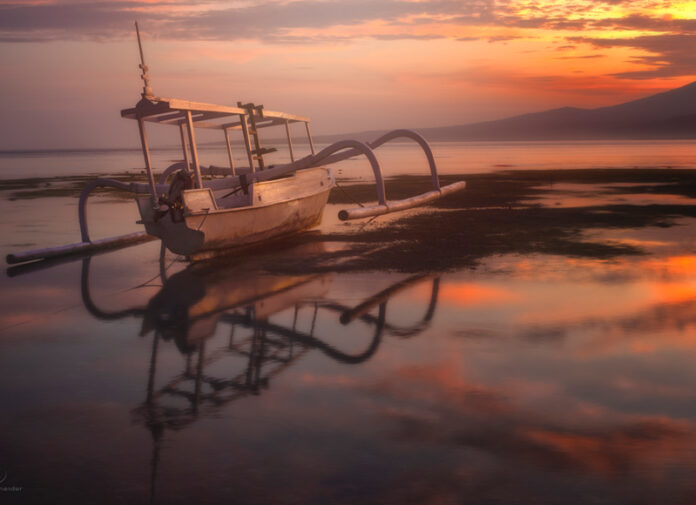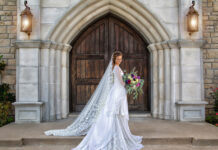by Kelly Schneider
Texas School Instructor
The sun has been emitting constant light for 4 billion years. Since the very beginning of humanity, those who can perceive light have done so with constant light. Continuous light is the source of almost everything that supports life and brings our world from out of the shadows. We were born seeing the world with constant light and this is one of the reasons why we can immediately recognize images that are formed using unnatural light directions and sources.
“Natural Light” sources include the sun, stars, fire, and electricity in storms. There are even some animals and plants that can create their own light, such as fireflies, jellyfish, and mushrooms. The SLR Lounge™ magazine describes Artificial Light as “any light source that is not naturally occurring.” Artificial Light includes things like flash/strobes, of course, but also any streetlights, indoor lighting, or other man-made light sources. This is often confused with “Ambient Light”, which can, in fact, include man-made light sources.
What about “ambient light”? – SLR Lounge™ states, “Ambient Light traditionally refers to any form of light that the photographer did not add to their image and can include both natural ambient sunlight or artificial ambient light such as a nearby streetlight, lamp, or similar.” As photographers, when you scout for a scene or prior to setting up your scene or studio, the light that exists is your ambient light. Many times, photographers unknowingly let some of the ambient light energy into their image exposure, and this light is either helping of hindering your efforts.
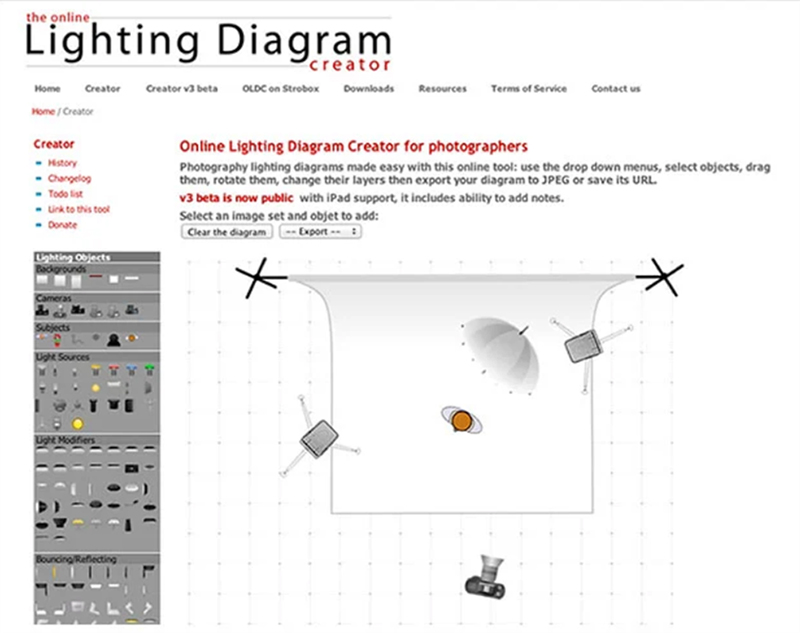
Luminous Architecture – Designer of light – “Architecture is the learned game, correct and magnificent, of forms assembled in the light.” – Le Corbusier
A Luminous Architect is, to me, a photographer who looks for, adds to, and controls light with a goal or objective to achieve some pre-defined vision in their final work. Most portrait photographers can be described as Luminous Architects. Luminous Architecture is a passion, a vocation, a calling — as well as a science and a business. It should be described as a social art and an artful science.
Some creatives spend as much time working out a lighting plan as they do taking the image, and others just move a subject to a spot that the ambient light works better. Back in 2017, I had an epiphany about designing light for a scene from a workshop by the incredibly-talented Tim Walden. His discussions and demonstrations on Relationship Portraits and the “Flow of Light” was a revelation to me on the critical role your light planning and design has in creating images that stand out. His book “Relationship Portraits: Capture Emotion in Black & White Photography” has many examples of how his lighting design is directly related to bring out the subjects in the frame that emphasize an emotional connection.
Modern Applications can help develop your lighting plan by quickly creating a graphical representation of the lighting “diagram” and this can also help by having a reference for later if you want to re-create with the same set up. The online “Lighting Diagram Creator” (http://www.lightingdiagrams.com/Creator) is designed to easily put vision into a plan.
Use of constant light sources and the ability to easily control it in a way to “create” an image is one main reason why we love using NanLite™ constant lights in our Fine Art portraiture work. This may include using natural sources of light and even ambient light (normally for fill) whether that is from artificial sources or not. This is the Luminous Architect process and LED lights with the WYSIWYG (What You See Is What You Get) capability makes this so much easier.
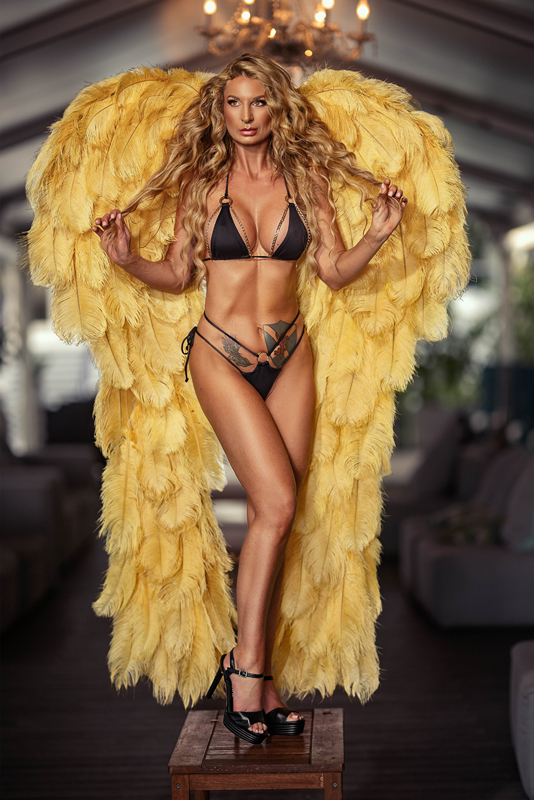
Light Emitting Diode (LED) Light – The modern natural light – More and more photographers are discovering the advantages of shooting with continuous “Light Emitting Diode” (LED) lighting, and Kalina Schneider and I are now not only sold on it but strongly advocate its use in most Fine Art portraiture shooting situations. We are surrounded by LED light almost everywhere we look or go. It is becoming a “natural light!”
LED lights are also making themselves valuable by reducing energy consumption in significant ways. The recent changes to rules and regulations in regard to bulbs that can be produced and used is based on the idea that we can save billions by just using LED bulbs in our homes and offices.
In the US alone, fluorescent lights consume around 200 terrawatt hours of electricity annually. If these lights were all replaced with 200 lm/W LEDs, the US would use around 100 terrawatt hours less energy. This equates to an annual saving of more than $12 billion and 60 million metric tons less CO2 being released into the atmosphere, equivalent to the emissions of around 17 coal-fired power plants, 12 million passenger vehicles, or 140 million barrels of oil consumed.
Shooting with continuous light also provides the creator the ability to “see” the results before the shutter release is pressed. Kalina and I are known for our moody and evocative portraiture, and we work hard to consistently have our work stand out (Salient). Being also educators who deliver one to seven-day intense photography workshops and inspired events in the US and abroad, “Chip-On-Board (COB) LED lighting has opened new creative possibilities for our work far beyond what can be done with strobes.
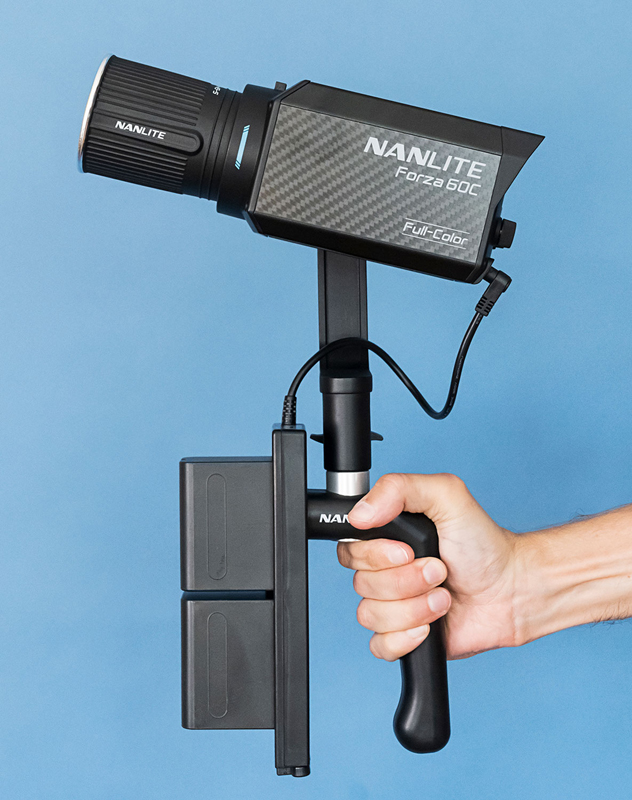
Strobes and flash units still have a role to play in modern photography, but LED lights have become the light of choice for more than 80 percent of our shooting needs in portraiture. For each LED technology advancement, use of traditional non-continuous lighting in photography fades.
How did this new COB LED light popularity come about? There have been several meaningful technological advancements that have profoundly changed how LED lights perform. Modern LED “COB lights” (see image right) are brighter than ever (Luminous efficacy), they provide high color-accuracy (CRI Index over 95) with the ability to easily fine-tune dimming and color, they run cool to the touch, and many can even be used in the field on battery power.
A little history of the LED – The idea for LED light originated in 1927 by a Russian inventor as a theory, and by 1961 the first LED light was created by accident. Using a microscope that looked at infrared light, two scientists observed light coming from the junctions of some electronics. As the lead scientist stated, “It was not a result of a project to come up with that idea.” They were not looking for LED light, but it was a result of being in the right place at the right time. They used the infrared microscope and saw certain junctions were glowing and were able to capitalize on it.
The first LED lights were red color and those were used in early calculator displays and remote controls. Then the Green LEDs were created followed by the Blue LEDs, and then, in 1993, using all three, the “White” LEDs were developed!
That was the beginning of the end for incandescent, florescent, and halogen bulbs. LED bulbs produce far greater light at much less energy so, for many reasons, it made sense.
We all know that the more efficient an LED, the more power (and money) savings it provides over the long run. Thanks to the efficiencies pioneered by these past scientists, many of today’s LEDs have life cycles of around 50,000 hours. If you break that down by years, it’s over a decade of running at 12 hours per day and at 8 hours a day, they can last 17 years. This lifespan is about 50 times that of incandescent bulbs.
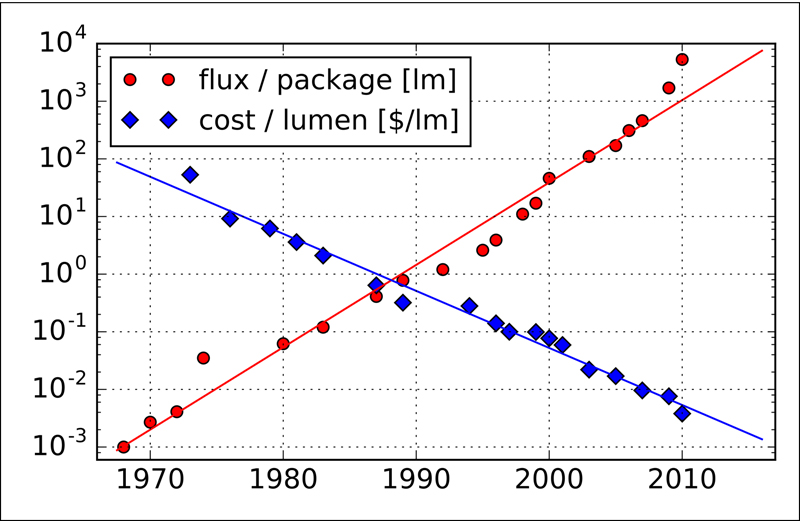
In photography, strobes were always the go-to light source to get the amount of light required for stopped-down apertures and faster shutter speeds, but this story has changed. Today’s LED lights are capable enough to bring full daylight to a 100,000-seat stadium in the middle of the night and do so with 80 percent less power than traditional lighting applications.
Over time, LED lights have continuously become brighter and brighter using less and less energy. This continuous improvement is called “Haitz’s Law.” For each decade, the cost of LED light per Lumen (unit of visual light emitted) falls by a factor of 10, and the amount of light generated increases by a factor of 20. Imagine what this means by 2030! (see Haitz’s Law Chart below)
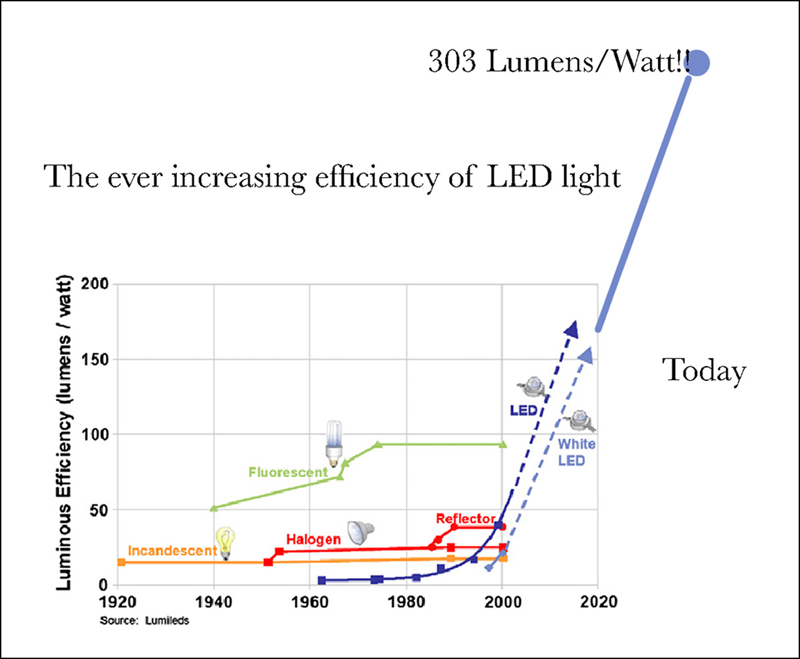
LED light is everywhere! The displays we see every day that provide us information we rely on, the TV screens (like OLED and the future MicroLED TVs with 25 million LEDs ) that provide such immersive images for our visual pleasure, and highly advanced military and medical uses, LED lighting is here for the foreseeable future.
Lumens (lm) vs Power (Wattsecond – ws) vs Guide Number (GN) – To compare constant light to strobe light, you must have an understanding of how light is measured. Most of today’s strobe manufacturers use “wattsecond” (ws) as a indicator of light intensity. The “ws” (e.g.200ws, 400ws, 600ws) of a strobe is not a measurement of the amount of light it produces but a measurement of a power supply in terms of how many wattseconds (Ws) of electrical energy available to deliver to the flash heads attached to it. The actual amount of visible light (Lumen) emitted in a specific direction after the power (ws) is sent to the flash head can be significantly affected by the flash head efficacy (how efficient it is), the light modifier used, and other factors.
Guide Numbers (GN) is another abused term in the world of photography. As Paul C. Buff clearly states, “A guide number tells the user nothing about the actual amount of light a certain flash unit can emit. Instead, the Guide Number (GN) term tells you what exposure you can expect on-axis from a given reflector. If a certain flash unit is fitted with a very narrow angle reflector, it can produce an extremely high GN. The same flash unit fitted with a wide-angle reflector or umbrella, will yield a much lower GN even though it is still producing the same amount of light. The GN is lower because the light is distributed over a wider area. Simply put: GNs have no place in comparing studio flash units and are largely marketing hype.”
In summary, LED COB lights are capable and continuously being designed with new and innovative technologies that increase light output (Lumens) and less and less power (remember Haitz’s law!), resulting in less and less reliance on strobe lighting for many applications.
What do strobes/Flashes and continuous lights have in common? – Strobes and continuous lights function extremely differently, however, the ways that you shape and soften their light are similar. Additionally, and as discussed prior, the light designing for both is similar albeit less challenging with constant light because of WYSIWYG.
Although strobes can have modeling lights to help give you a basic idea of the light pattern, constant lights will render the scene accurately to our eye as you want to capture it. You SEE the final image in front of you with constant lights. If your spread of light is too great or two shallow, you can see it and make the needed changes. If the flow of light on your subject does not coincide with your focal point (your aiming), you can make corrections before you even pick up your camera.
Light modifiers, like softboxes, scrims, snoots, and even projectors, are often used on both types of light sources and they are interchangeable for most applications. You can use these tools on both lights.
When creating your lighting (Luminous Architecture) to bring to life your image using strobes or constant lights, it is generally the same. The use of Primary, Hair, Key, Fill, Background, or other lights can be achieved with strobes or constant lights in a similar way.
Another modern innovation available for both types of light is the use of smartphone applications (like the NanLink™ app) that lets you sit back and perform wireless lighting control no matter how complex the situation.
What do strobes/Flashes and continuous lights NOT have in common?
Did you say VIDEO? For almost 99 percent of video lighting needs, constant lights are the answer and strobes are almost irrelevant. In today’s visual world, motion and video is becoming more and more the preferred advertisement method and thus, having some constant light tools is critical.
If producing high-quality video (and most of today’s professional cameras have this capability) is part of your business or you plan to add it to your business, constant lighting will be needed. Whether you are doing live, online feeds, or you generate video to create reels and other social media content, there is only one answer: Constant light and the best is COB LED Lights like you find with NanLite™products.
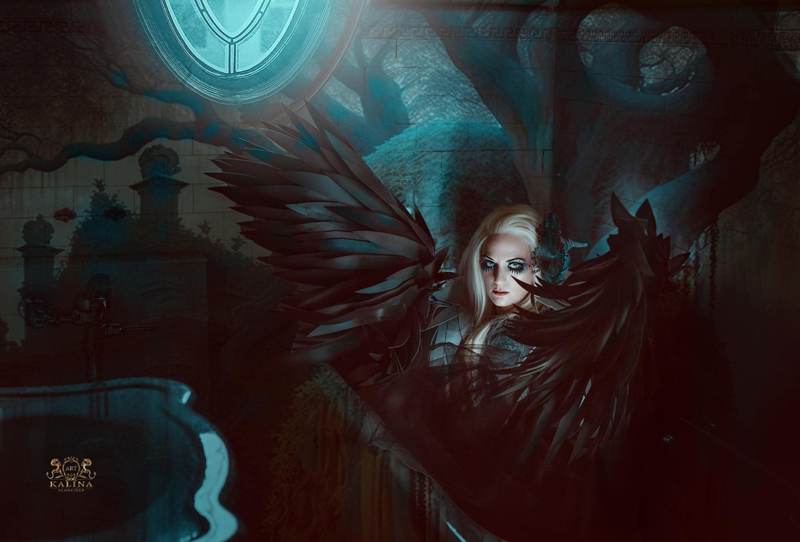
With constant light, there is no need for Radio Frequency (RF) or Infrared triggers or receivers to provide your light. There is no need to “Sync” your camera to the light sources. Strobes fire extremely short duration flashes of light, and this requires the camera and light unit to communicate to synchronize themselves and usually that means being connected in some way. Additionally, with constant light, the camera can use all available shutter speeds that result in the desired exposure (within limits of the camera) naturally versus the requirement for High Speed Synchronization or Auto Focal Plane (Auto FP) modes due to limits on mechanical shutters.
Mean Time Between Failure (MTBF) – How long will they last? – Strobes and flash tubes have benefited by innovation and can last 100’s of times longer than those of even a decade ago. For example, the GODOX FT-AD600 600ws flash tube is rated between 100,000 and 250,000 flashes so that could represent years of service or just months for volume sales. LED COB lights have an average life expectancy of 50,000 hours; that means using them for 8 hours every day for the next 17 years. I think the LED COB light will last longer than most will be shooting!
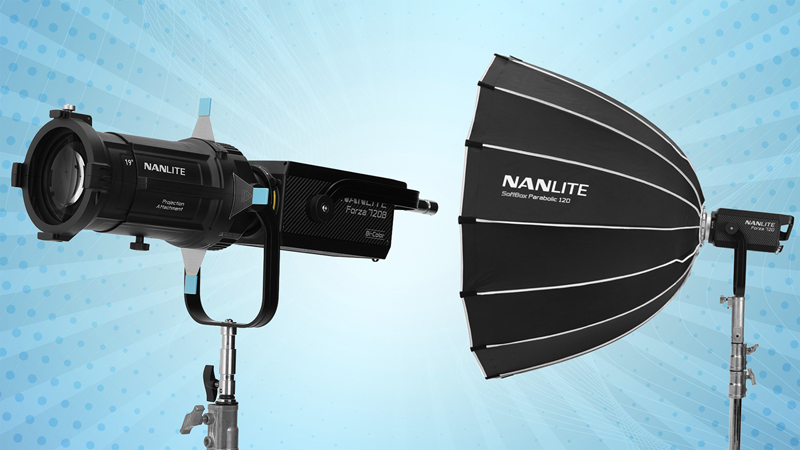
Warranty – Understanding the MTBF above, the warranty on LED COB Lights can be extended as they last longer. For example, the Nanlite™ warranty is 3 years when registered with Nanlite™ USA and the GODOX is 1 year (Batteries are 6 months).
Stopping action capability – Here is an area that the more powerful strobes and flashes have a slight edge. Strobes can freeze action using extremely high shutter speeds. LED COB Lights, to render images with similar looks, need much higher power units that may be cost-prohibitive to some photographers, but that is changing. For example, the NanLite™ FORZA 720b (bicolor) COB LED Light can produce extremely bright and accurate color (CRI 96) at anytime of the day.
Output Luminosity variation (Tweak the output) – Most COB LED lights are nimble enough to dim from 0 to 100 percent with 0.1 percent increments always letting you fine-tune for your needs, but strobes are usually limited to between 10 levels or 1/3 increments from 1/256 power to full power (27 levels).
COLOR output – LED COB Lights with RBG capability bring the rainbow to your creative world and without the need for gels or other modification that can also decrease a light’s ability and output. Additionally, many LED COB lights with the bi-color option bi-color LEDs give you the CCT range of 2700-6500K, giving you the ability to mimic warm indoor lamp light and the golden hues of sunsets, not something the strobes or flashes can do without modification and expense.
Light Painting – Constant lights are the preferred light source for light painting. The abilities of COB LED Lights are unmatched for this type of photography and with the addition of Bi-Color and RGB color, the creative possibilities are endless. We plan to play with this in our 2024 Texas School class!
Why is Nanlite™ our choice for photography? – Just a few seconds holding one or seeing what they do will definitely make an impact. Solid construction, and even the cases with the FORZA lights are exceptional and make travel with them easy. The light tubes can be used underwater! The Forza 60C RGB color three light kit comes with a hard case, too. We take it overseas with us as checked bag that rolls.
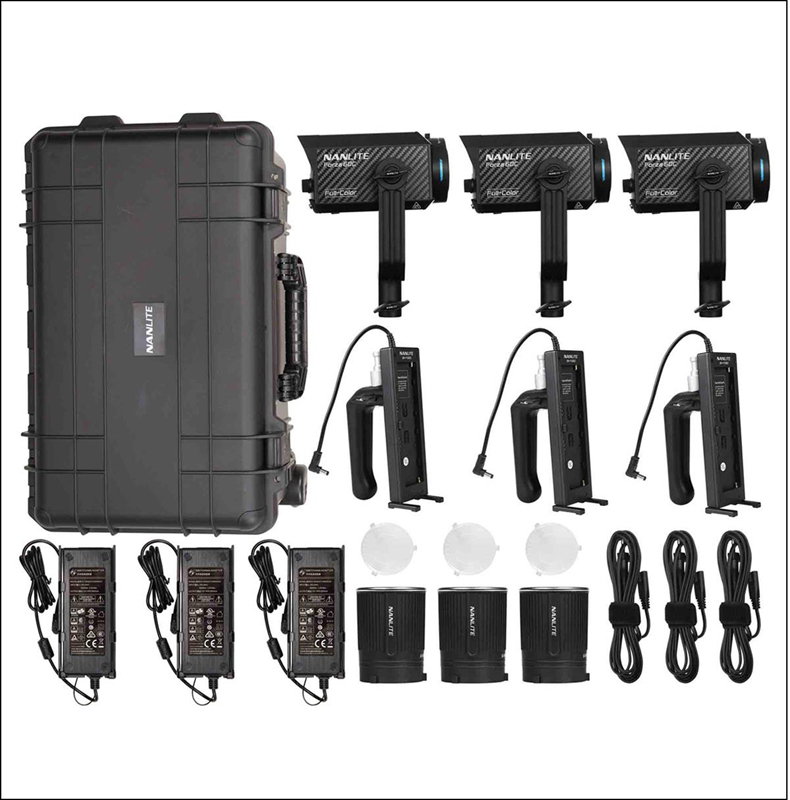
One thing that sets Nanlite™ apart from other options is the company itself. They have been designing and building LED lights exclusively for photography and video production for more than 30 years. They manufacture most of their products in their own factory, which gives them the best quality control and one of the reasons for 2–3-year warranties.
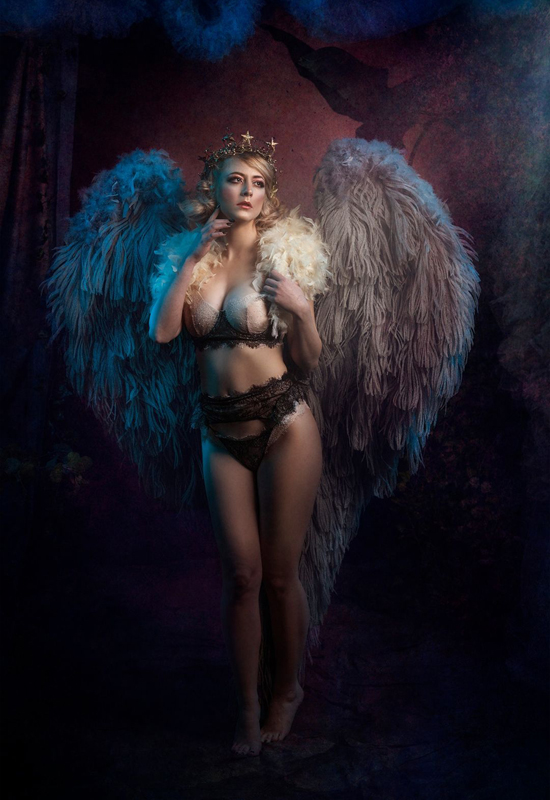
Most of other LED light manufactures have their lights contractually made in third-party factories. At Nanlite™, and with NanLite™ USA, they can resolve issues firsthand and get it done efficiently. When I need support, there is a NanLite™ USA representative close by.
Investing in lighting has always been one of the most important procurements you can make as a photographer. Your selection of brand is usually one you try to stay loyal to over the years as changing the your gear “ecosystem” can be costly, but staying with one can also be detrimental to your growth.
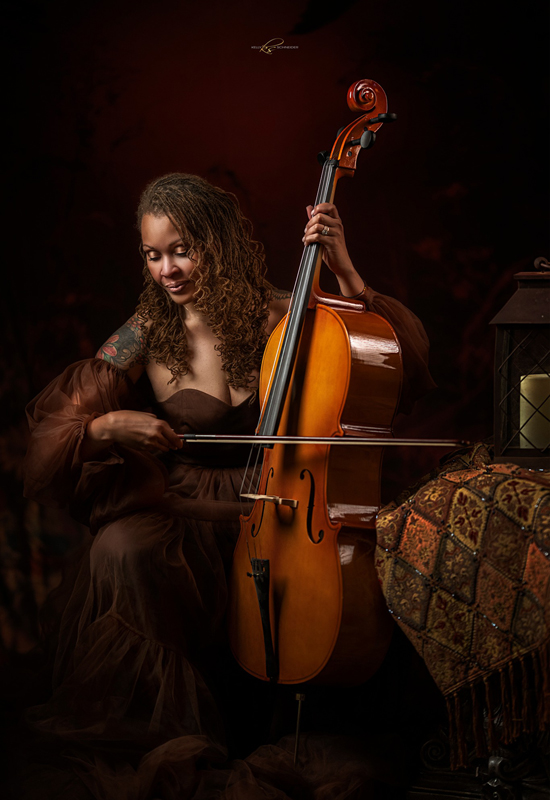
A brand’s Ecosystem (I heard that once from someone else and it is an awesome term) of products can be directly related to your future costs and gear options. Sometimes third party options surpass the original brand choices. As innovation presents us with new creative ways to stay relevant as a visual creative, we must constantly be making hard decisions on where our investment is focused with return on investment (ROI) unknowns. Studios need to maintain a “sustained innovation” approach to these decisions. COB LED lights are here to stay, and the benefits to us are obvious. If you have not invested in this technology, maybe it’s time to evaluate how it may take you to the next level.
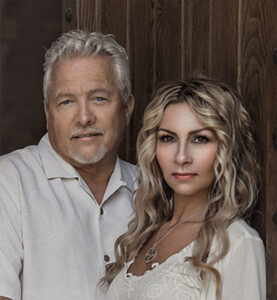 Kelly and Kalina Schneider are both Master Photographers and Photographic Craftsmen from Cape Coral, Florida. At the 2024 Texas School of Professional Photography, they will be teaching a class on “The Fine Art Portraiture Awakening.” This class will re-awaken your creative spirit through a deep-dive in styling and storytelling in your portraits, and you will have a new understanding of the use of different types of lighting (natural, reflected, LED, strobes, etc.) in a masterful way that will consistently result in images that speak to others.
Kelly and Kalina Schneider are both Master Photographers and Photographic Craftsmen from Cape Coral, Florida. At the 2024 Texas School of Professional Photography, they will be teaching a class on “The Fine Art Portraiture Awakening.” This class will re-awaken your creative spirit through a deep-dive in styling and storytelling in your portraits, and you will have a new understanding of the use of different types of lighting (natural, reflected, LED, strobes, etc.) in a masterful way that will consistently result in images that speak to others.
In addition to their PPA degrees, Kelly holds a Master of Science in Human Systems Engineering, has been teaching complex skills in the Department of Defense for over 31 years, and worked as the Director of Training for the FORD Class Nuclear Aircraft Carrier program in Washington, D.C. Kalina has a Masters degree in art from Poland and she also worked for the National Gallery of Art for more than 10 years. Together, they bring a blend of advance-technical skills and a deep artistic vision to their work. Learn more about them at: www.ksfinearts.com.



